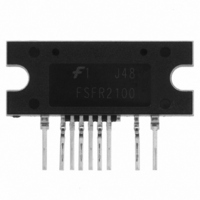FSFR2100 Fairchild Semiconductor, FSFR2100 Datasheet - Page 9

FSFR2100
Manufacturer Part Number
FSFR2100
Description
IC SWIT PROG OVP OCP 9SIP
Manufacturer
Fairchild Semiconductor
Series
FPS™r
Datasheet
1.FSFR2100.pdf
(16 pages)
Specifications of FSFR2100
Output Isolation
Isolated
Frequency Range
94kHz ~ 106kHz
Voltage - Input
9.6 V ~ 25 V
Voltage - Output
500V
Power (watts)
400W
Operating Temperature
-40°C ~ 130°C
Package / Case
9-SIP
Output Voltage
24 V
Output Current
8.3 A
Output Power
450 W
Switching Frequency
300 KHz
Operating Temperature Range
- 40 C to + 130 C
Mounting Style
Through Hole
Duty Cycle (max)
52 %
Isolated/non-isolated
Isolated
For Use With
FEB212 - BOARD EVAL FOR FSFR2100
Lead Free Status / RoHS Status
Lead free / RoHS Compliant
Available stocks
Company
Part Number
Manufacturer
Quantity
Price
Part Number:
FSFR2100
Manufacturer:
FAIRCHILD/仙童
Quantity:
20 000
Company:
Part Number:
FSFR2100U
Manufacturer:
Fairchild Semiconductor
Quantity:
1 885
Part Number:
FSFR2100U
Manufacturer:
CN/如韵
Quantity:
20 000
Company:
Part Number:
FSFR2100XS
Manufacturer:
RENESAS
Quantity:
2 500
Part Number:
FSFR2100XS
Manufacturer:
FCS
Quantity:
20 000
© 2007 Fairchild Semiconductor Corporation
FSFR2100 • Rev.1.0.8
Functional Description
1. Basic Operation
FSFR2100 is designed to drive high-side and low-side
MOSFETs complementarily with 50% duty cycle. A fixed
dead time of 350ns is introduced between consecutive
transitions, as shown in Figure 16.
2. Internal Oscillator
FSFR2100 employs a current-controlled oscillator, as
shown in Figure 17. Internally, the voltage of R
regulated at 2V and the charging/discharging current for
the oscillator capacitor, C
current flowing out of R
Therefore, the switching frequency increases as I
increases.
3. Frequency Setting
Figure 18 shows a typical voltage gain curve of a
resonant
proportional to the switching frequency in the ZVS region.
The output voltage can be regulated by modulating the
switching frequency. Figure 19 shows the typical circuit
configuration for R
is connected to the R
frequency.
Figure 17. Current Controlled Oscillator
Figure 16. MOSFETs Gate Drive Signal
converter,
T
pin, where the opto-coupler transistor
where
T
T
pin (I
pin to modulate the switching
T
, is obtained by copying the
CTC
the
) using a current mirror.
gain
is
inversely
T
pin is
CTC
9
The minimum switching frequency is determined as:
Assuming
transistor is 0.2V, the maximum switching frequency is
determined as:
To prevent excessive inrush current and overshoot of
output voltage during startup, increase the voltage gain
of the resonant converter progressively. Since the
voltage gain of the resonant converter is inversely
proportional to the switching frequency, the soft-start is
implemented by sweeping down the switching frequency
from an initial high frequency (f
voltage is established. The soft-start circuit is made by
connecting R-C series network on the R
f
f
Figure 18. Resonant Converter Typical Gain Curve
min
max
=
=
Gain
1.8
1.6
1.4
1.2
1.0
0.8
0.6
5.2
(
5.2
R
60
Figure 19. Frequency Control Circuit
R
R
min
k
min
max
k
Ω
the
Ω
70
×
+
100(
4.68
80
saturation
f
R
R
min
kHz
max
min
C
k
90
Ω
ss
)
) 100(
×
f
CON
R
100
normal
RT
ss
freq (kHz)
voltage
110
kHz
Control
f
I S S
120
)
max
LVcc
Soft-start
IC
SG
) until the output
130
of
T
pin, as shown
www.fairchildsemi.com
VDL
f
140
opto-coupler
ISS
PG
150
(1)
(2)












